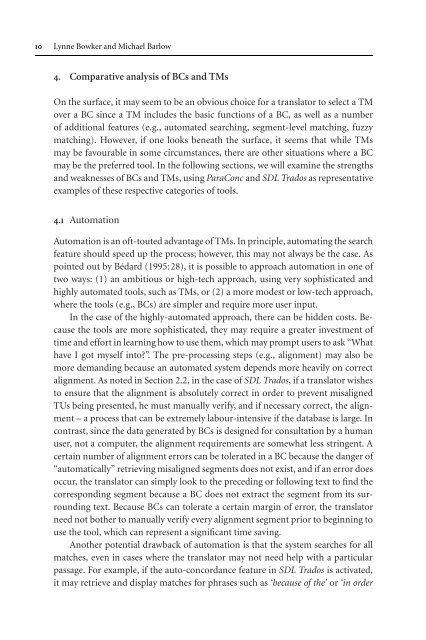Topics in Language Resources for Translation ... - ymerleksi - home
Topics in Language Resources for Translation ... - ymerleksi - home
Topics in Language Resources for Translation ... - ymerleksi - home
- No tags were found...
Create successful ePaper yourself
Turn your PDF publications into a flip-book with our unique Google optimized e-Paper software.
10 Lynne Bowker and Michael Barlow4. Comparative analysis of BCs and TMsOn the surface, it may seem to be an obvious choice <strong>for</strong> a translator to select a TMoveraBCs<strong>in</strong>ceaTM<strong>in</strong>cludesthebasicfunctionsofaBC,aswellasanumberof additional features (e.g., automated search<strong>in</strong>g, segment-level match<strong>in</strong>g, fuzzymatch<strong>in</strong>g). However, if one looks beneath the surface, it seems that while TMsmaybefavourable<strong>in</strong>somecircumstances,thereareothersituationswhereaBCmay be the preferred tool. In the follow<strong>in</strong>g sections, we will exam<strong>in</strong>e the strengthsand weaknesses of BCs and TMs, us<strong>in</strong>g ParaConc and SDL Trados as representativeexamples of these respective categories of tools.4.1 AutomationAutomation is an oft-touted advantage of TMs.Inpr<strong>in</strong>ciple,automat<strong>in</strong>gthesearchfeature should speed up the process; however, this may not always be the case. Aspo<strong>in</strong>ted out by Bédard (1995: 28), it is possible to approach automation <strong>in</strong> one oftwo ways: (1) an ambitious or high-tech approach, us<strong>in</strong>g very sophisticated andhighly automated tools, such as TMs, or (2) a more modest or low-tech approach,where the tools (e.g., BCs) are simpler and require more user <strong>in</strong>put.In the case of the highly-automated approach, there can be hidden costs. Becausethe tools are more sophisticated, they may require a greater <strong>in</strong>vestment oftime and ef<strong>for</strong>t <strong>in</strong> learn<strong>in</strong>g how to use them, which may prompt users to ask “Whathave I got myself <strong>in</strong>to?”. The pre-process<strong>in</strong>g steps (e.g., alignment) may also bemore demand<strong>in</strong>g because an automated system depends more heavily on correctalignment. As noted <strong>in</strong> Section 2.2, <strong>in</strong> the case of SDL Trados, if a translator wishesto ensure that the alignment is absolutely correct <strong>in</strong> order to prevent misalignedTUs be<strong>in</strong>g presented, he must manually verify, and if necessary correct, the alignment– a process that can be extremely labour-<strong>in</strong>tensive if the database is large. Incontrast, s<strong>in</strong>ce the data generated by BCs is designed <strong>for</strong> consultation by a humanuser, not a computer, the alignment requirements are somewhat less str<strong>in</strong>gent. Acerta<strong>in</strong> number of alignment errors can be tolerated <strong>in</strong> a BC because the danger of“automatically” retriev<strong>in</strong>g misaligned segments does not exist, and if an error doesoccur, the translator can simply look to the preced<strong>in</strong>g or follow<strong>in</strong>g text to f<strong>in</strong>d thecorrespond<strong>in</strong>g segment because a BC does not extract the segment from its surround<strong>in</strong>gtext. Because BCs can tolerate a certa<strong>in</strong> marg<strong>in</strong> of error, the translatorneed not bother to manually verify every alignment segment prior to beg<strong>in</strong>n<strong>in</strong>g touse the tool, which can represent a significant time sav<strong>in</strong>g.Another potential drawback of automation is that the system searches <strong>for</strong> allmatches, even <strong>in</strong> cases where the translator may not need help with a particularpassage. For example, if the auto-concordance feature <strong>in</strong> SDL Trados is activated,itmayretrieveanddisplaymatches<strong>for</strong>phrasessuchas‘because of the’ or ‘<strong>in</strong> order
















